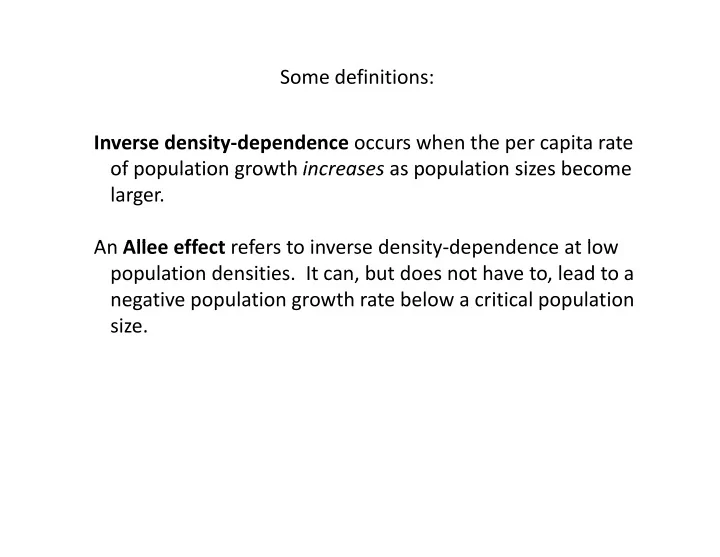

Some definitions: Inverse density ‐ dependence occurs when the per capita rate of population growth increases as population sizes become of population growth increases as population sizes become larger. An Allee effect refers to inverse density ‐ dependence at low A All ff t f t i d it d d t l population densities. It can, but does not have to, lead to a negative population growth rate below a critical population size.
Some mechanisms that lead to Allee effects: • Demographic stochasticity (particularly w.r.t. sex ratios) • Loss of genetic diversity Loss of genetic diversity • => mutational meltdown • => exposure of deleterious recessives through i b inbreeding di • Loss of cooperative benefits • => defense (for prey, or pathogens) • => foraging success (for predators) • => inability to attract pollinators • => loss of ‘environmental conditioning’ (plants) > loss of environmental conditioning (plants) • => many others
Genetic drift is less effective at eliminating mildly deleterious mutations in small populations N=20 N=50 N=200
The extinction vortex (a term coined by Gilpin & Soulé, 1986) suggests that “as populations decline an insidious mutual suggests that as populations decline, an insidious mutual reinforcement can occur among biotic and abiotic processes such as environmental stochasticity, demographic stochasticity, inbreeding, and behavioural failures, driving population size downward to extinction” (text from Fagan & Holmes, 2006) . , ) A major prediction of the extinction vortex is that “declines beget further declines” thus accelerating a population’s beget further declines , thus accelerating a population s collapse as species near extinction.
Fagan & Holmes ( Ecology Letters 2006): evidence for an extinction vortex in local extinctions of vertebrates? extinction vortex in local extinctions of vertebrates?
Population ecology (led by Sir Robert May) played a major role in the mathematical discovery of chaos in the early y y 1970s. Chaos is found in systems with strong non ‐ linearities Chaos is found in systems with strong non linearities. Discrete ‐ time population growth models with strong density ‐ dependence provide such a setting. One of the signatures of chaos is a sensitive dependence on initial conditions. This sensitive dependence implies that chaotic systems are fundamentally unpredictable over long time scales, even in the absence of stochasticity. The 1980s witnesses an enthusiastic hunt for chaotic dynamics in ecological systems. Ultimately, the pursuit fi l d fizzled without any satisfactory resolution. ith t ti f t l ti
Chaos: sensitive dependence on initial conditions Red begins with N 0 =0.5. Blue begins with N 0 =0.5001.
Recommend
More recommend